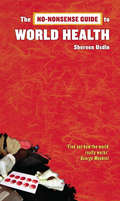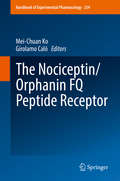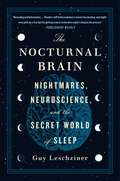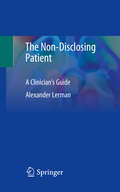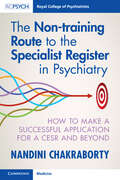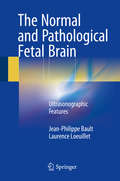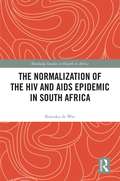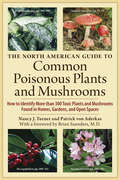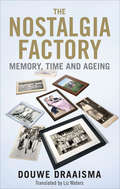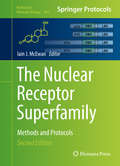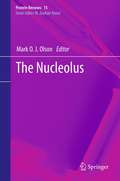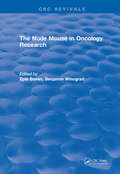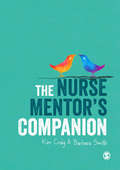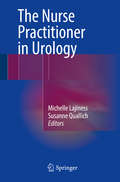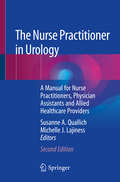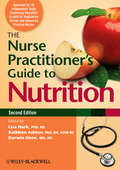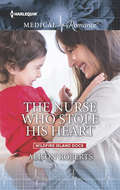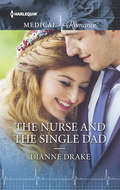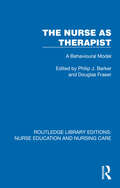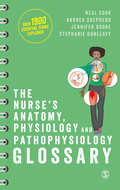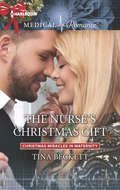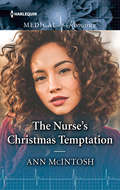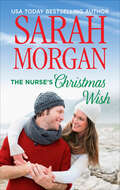- Table View
- List View
The No-Nonsense Guide to World Health
by Shereen UsdinA clear yet wide-ranging introduction to the state of health worldwide, exploring the ways in which health provision is often determined by ethnicity, class, and gender. Starting with a brief history of medical progress, this guide delves into current politics of health in the contexts of big business and private health provision, media, gender, and the environment. Shereen Usdin is a medical doctor and a public health specialist. She is co-founder of the internationally acclaimed Soul City for Health and Development Communication in South Africa and works in the areas of development communication, HIV/AIDS, violence against women, and human rights.
The Nociceptin/Orphanin FQ Peptide Receptor (Handbook of Experimental Pharmacology #254)
by Mei-Chuan Ko Girolamo CalóThe aim of this book is not only to introduce readers with a broad spectrum of biological actions of the NOP receptor, but also to feature a detailed look at the N/OFQ-NOP receptor system, medicinal chemistry, pharmacology, and clinical data of NOP-targeted ligands. This special volume book - for the first time focusing on the NOP receptor - is designed to serve as a useful reference, stimulate more research on the N/OFQ-NOP receptor system, and lead to more development of NOP-related ligands for several therapeutic applications.
The Nocturnal Brain: Nightmares, Neuroscience, and the Secret World of Sleep
by Dr. Guy LeschzinerA renowned neurologist shares the true stories of people unable to get a good night’s rest in The Nocturnal Brain: Nightmares, Neuroscience, and the Secret World of Sleep, a fascinating exploration of the symptoms and syndromes behind sleep disorders.For Dr. Guy Leschziner’s patients, there is no rest for the weary in mind and body. Insomnia, narcolepsy, night terrors, apnea, and sleepwalking are just a sampling of conditions afflicting sufferers who cannot sleep—and their experiences in trying are the stuff of nightmares. Demoniac hallucinations frighten people into paralysis. Restless legs rock both the sleepless and their sleeping partners with unpredictable and uncontrollable kicking. Out-of-sync circadian rhythms confuse the natural body clock’s days and nights.Then there are the extreme cases. A woman in a state of deep sleep who gets dressed, unlocks her car, and drives for several miles before returning to bed. The man who has spent decades cleaning out kitchens while “sleep-eating.” The teenager prone to the serious, yet unfortunately nicknamed Sleeping Beauty Syndrome stuck in a cycle of excessive unconsciousness, binge eating, and uncharacteristic displays of aggression and hypersexuality while awake.With compassionate stories of his patients and their conditions, Dr. Leschziner illustrates the neuroscience behind our sleeping minds, revealing the many biological and psychological factors necessary in getting the rest that will not only maintain our physical and mental health, but improve our cognitive abilities and overall happiness.
The Non-Disclosing Patient: A Clinician's Guide
by Alexander LermanThis volume is to examine the phenomena of non-disclosure in its wide ranging forms, study its properties, and to deepen the capacity of a mental health professional --as well as all clinicians who provide mental health counseling -- to detect and engage it across a range of clinical settings. Unengaged, sustained DNDD represents an impasse that is destructive to a clinician’s capacity to both understand and treat a patient. Successfully engaged, on the other hand, DNDD offers a unique perspective on in individuals anxieties, presuppositions, and mental functioning. A clinician who is both aware that a patient is withholding information, and comfortable with that awareness, may approach the patient material while listening for both indications of non-disclosed material and—critically—a growing awareness of psychopathology or other motivational forces driving non-disclosure.Written by experts in this area from both adult and child psychiatric specialties, this book is the first to address the issue of DNDD and present clinical pearls for addressing it. This text is a valuable resource for psychiatrists, psychologists, addiction medicine specialists, family physicians, and a wide array of clinicians treating patients who may struggle with disclosure and integrity.
The Non-training Route to the Specialist Register in Psychiatry: How to Make a Successful Application for a CESR and Beyond
by Nandini ChakrabortySubstantive consultants in the UK need to be on the GMC specialist register. Non-consultant psychiatrists might work towards the GMC specialist register in psychiatry through various routes, of which CESR is one. This book, written by experts with first-hand experience, provides guidance to doctors planning to use this route. Specialist registration is the acknowledgement of a doctor's expertise in their field and the achievement of competences as outlined in specialist curricula. This book provides a succinct overview of what to expect from the process of applying for CESR, with practical advice on how to submit a successful application. It will appeal primarily to Speciality and Associate Specialist (SAS) Doctors with extensive experience in psychiatry, psychiatrists who have completed their training overseas and wish to practice in the UK, as well as medical managers and educators supporting their workforce towards consultant grade.
The Normal and Pathological Fetal Brain
by Jean-Philippe Bault Laurence LoeuilletThis book provides assistance in preparing for and conducting screening or diagnostic ultrasound examinations of the fetal brain in all stages of pregnancy. Readers are provided with: abundantly illustrated descriptions of studies conducted on normal brain structures using all conventional and 3D/4D ultrasound techniques; a detailed description of the main structures of the brain; photographs of fetal pathology specimens that may be used to compare the results of imaging techniques with the anatomical reality; and practical advice and technical tips. The second part of this book presents a clear and informative overview of fetal brain pathologies, combining a wealth of detailed images and precise descriptions.
The Normalization of the HIV and AIDS Epidemic in South Africa (Routledge Studies in Health in Africa)
by Katinka de WetThis book explores the normalization of HIV and AIDS, reflecting upon the intended and unintended consequences of the multifarious "AIDS industry." The Normalization of the HIV and AIDS Epidemic in South Africa deals with the manner in which the HIV and AIDS epidemic has become such a well-known disease with such wide-ranging ramifications. With its focus on the "AIDS industry," this book examines issues such as the framing of the HIV and AIDS epidemic in a manner that greatly fostered notions of stigmatization and moralization. This book looks at the complexities of dealing with the epidemic in contemporary South Africa, examining the difficulties of addressing the social aspects of a disease in the context of increased focus on technological quick-fix solutions. De Wet explores these issues thoroughly, looking at the social determinants of the spread of the disease as well as the configuration and the nature of the responses to it, and their increasing marginalization as factors to address in an era of increased biomedicalization and concomitant normalization. This book will intrigue scholars and students of public health, global health care, medical sociology, and African Studies.
The North American Guide to Common Poisonous Plants and Mushrooms
by Nancy J. Turner Patrick Von AderkasIf people knew how many poisonous plants are commonly found in homes and gardens, they'd be shocked. Plants as common as monkshood, castorbean, and oleander are not just dangerous, they're deadly.The North American Guide to Common Poisonous Plants and Mushrooms is a comprehensive, easy-to-use handbook. The book is split into four main categories: mushrooms, wild plants, ornamental and crop plants, and houseplants. Each plant entry includes a clear photograph to aid the task of identification, a description of the plant, notes on where they commonly occur, and a description of their toxic properties. Plants are listed by common name to assist the non-specialist.
The Nostalgia Factory: Memory, Time and Aging
by Douwe Draaisma&“An entertaining discussion&” of the role memory plays in our lives as we age, including an interview with Oliver Sacks (Times Higher Education Supplement). When we can&’t call to mind the name of someone we&’ve known for years, or walk into a room and forget what we came for, we start worrying. Are these lapses just &“senior moments,&” or something serious like dementia? In this book, a renowned specialist explores the topic of memory in later life—not only the problems but the surprisingly unexpected pleasures it can offer, such as the &“reminiscence effect.&” Avoiding jargon, Douwe Draaisma explains neurological phenomena and also includes a long interview with Oliver Sacks, who speaks of his own memory changes as he entered his sixties. Draaisma moves smoothly from anecdote to research and back, weaving stories and science into a compelling description of the terrain of memory and forgetfulness, dismantling myths and helping us to value the abilities of the aging mind. &“For readers, the most welcome aspect of this book may be his heartening examples of the wisdom that comes with old age.&”—The Washington Post &“He engages with topics of considerable social and psychological importance…his use of varied sources is refreshing.&”—Times Higher Education Supplement
The Nuclear Receptor Superfamily
by Iain J. McewanActing principally to control patterns of gene expression, nuclear receptors play vital roles during embryonic development and in the regulation of metabolic and reproductive functions in adult life, which proves this superfamily of ligand-activated transcription factors to be a crucial part of biological life. In The Nuclear Receptor Superfamily: Methods and Protocols, expert researchers describe a range of molecular, structural and cell biological techniques currently used to investigate the structure-function of nuclear receptors, together with experimental approaches that may lead to new therapeutic strategies for treating nuclear receptor-associated diseases. Written in the highly successful Methods in Molecular BiologyTM series format, the chapters in this volume contain brief introductions to the topics, lists of the necessary materials and reagents, step-by-step, readily reproducible laboratory protocols, as well as notes from the experts to highlight tips on troubleshooting and avoiding known pitfalls. Cutting-edge and easy to use, The Nuclear Receptor Superfamily: Methods and Protocols provides beneficial and time-saving guidance for all those undertaking research in this ever-growing field of study.
The Nucleolus
by Mark O. OlsonWithin the past two decades, extraordinary new functions for the nucleolus have begun to appear, giving the field a new vitality and generating renewed excitement and interest. These new discoveries include both newly-discovered functions and aspects of its conventional role. The Nucleolus is divided into three parts: nucleolar structure and organization, the role of the nucleolus in ribosome biogenesis, and novel functions of the nucleolus.
The Nude Mouse in Oncology Research
by Epie BovenThe nude, athymic mouse (nu/nu) has become generally accepted as a valuable tool to study the biology and therapy of human cancers. This volume presents a critical review of the scientific merits of the animal as a recipient of human tumor tissue transplants. Important information is provided regarding biology, immunology, and measures for genetic and microbiological control of the nude mouse. The discussion of transplantation sites and transplantability of human tumor tissue to the animals includes both the description of host factors and the tumor type involved. The characterization and monitoring of xenografts is followed by a review on their possible application for studies in tumor biology, such as hormones, growth factors, drug resistance, tumor markers, and heterogeneity. Experimental therapy is dedicated to cytostatic agents, hormones, monoclonal antibodies, cytokines, differentiation inducers and radiotherapy. The book also provides critical remarks regarding the limitation of the nude-mouse tumor models. The Nude Mouse in Oncology Research will provide essential reference information for oncology researchers, researchers who work with the nude mouse on a regular basis, and pharmaceutical companies.
The Nurse Mentor's Companion
by Barbara Smith Kim CraigThis is a new highly practical guide to doing mentoring in practice. It explains how to support student nurses from the day that they arrive on placement in six straightforward, concise and clear chapters. The book is packed full of resources and learning features, including: Action plans for managing your student Checklists of resources you will need Tips for best practice Case studies covering all fields of nursing Reflective questions which challenge you to question your assumptions. Chapters are tied closely to the NMC standards, and cover essential topics including assessment, the role of the sign-off mentor and team-working. The Nurse Mentor's Companion is valuable reading for all nurses taking mentoring courses across the UK, and as they go on to mentor in practice.
The Nurse Practitioner in Urology
by Michelle Lajiness Susanne QuallichThis book is designed to meet the needs of nurse practitioners, advanced practice nurses and also physician assistants, working in urology. The full range of domains of practice is covered, including assessment and diagnosis, clinical management, nurse practitioner and patient relationships, consultation, health promotion and disease prevention, and practice management and research. Some background knowledge is assumed regarding the normal anatomy and physiology of the genitourinary system and the pathophysiology underlying specific urologic health-related problems. The Nurse Practitioner in Urology will be invaluable in ensuring that the nurse practitioner is able to maintain exemplary management of patients with acute and chronic urologic conditions in a wide variety of settings, including independent practices, hospitals, and academic urologic practices. It explains fully the role of the nurse practitioner as a skilled clinician in urology, blending nursing and medical management and capable of managing many chronic nonoperative urologic conditions while recognizing those conditions which may benefit from surgical management. As populations continue to age worldwide, there is no doubt that the provision of advanced urologic care by nurse practitioners is an area that will continue to expand, benefiting from additional training and expertise.
The Nurse Practitioner in Urology: A Manual for Nurse Practitioners, Physician Assistants and Allied Healthcare Providers
by Susanne A. Quallich Michelle J. LajinessThis new edition updates the previous one and adds additional content related to postoperative management, pain management, LGBTQ care, and uroradiology. This book is designed to meet the needs of nurse practitioners, advanced practice nurses globally and physician assistants working in urology. Content assumes some background knowledge regarding the normal anatomy and physiology of the genitourinary system and the pathophysiology underlying specific urologic health-related problems. This ensures that the provider can pursue exemplary management of patients with acute and chronic urologic conditions in a wide variety of settings, including independent practices, and academic urologic practices. This manual fills the gaps that traditional curricula may have left, permitting the reader to proceed with confident management of adult patients with urologic care needs, promoting the role of a skilled clinician in urology, especially for chronic, non-operative urologic conditions while recognizing those conditions which may benefit from surgical management.As the burden of urologic disease increases with an aging U.S. population, it is increasingly clear that nurse practitioners and physician assistants will be called on to move into roles caring for patients with urologic disease. Use of NPs and PAs to their highest education will become an increasingly important strategy for maintaining access and reducing costs, in the context of urologist workforce that is shrinking. However, urology topics receive sporadic attention in NP and PA curricula, leaving practicing NPs and PAs with gaps in their knowledge concerning trends and recommendations for management of urologic health conditions. As this demand for provider visits for urologic concerns increases, the demand for provider services to care for patients with urologic health concerns will also increase, and presents the opportunity for both NPs and PAs to move into specialty practice environments within urology.
The Nurse Practitioner's Guide to Nutrition
by Kathleen Ashton Darwin Deen Lisa HarkThe Nurse Practitioner's Guide to Nutrition is a comprehensive clinical resource for nurse practitioners working in a variety of clinical care settings. Emphasizing practical nutrition information, this accessible guide provides guidance on incorporating nutrition history questions and counselling techniques into routine care across all clinical settings.The book begins by discussing fundamental concepts in nutrition assessment, giving readers a solid framework from which to approach subsequent chapters. Section Two focuses on nutrition from a lifespan perspective, organizing information by the issues most pertinent to patients at different stages of life. Section Three presents nutrition counselling across clinical care settings ranging from cardiology, endocrinology, oncology, and gastroenterology to caring for the obese patient.Each chapter includes essential information distilled in quick-access tabular format and clinical scenarios that apply key concepts discussed to real-world examples. Ideal for both in-training and qualified advanced practice nurses, The Nurse Practitioner's Guide to Nutrition is an essential tool for assessing, managing, and treating nutrition-related conditions, as well as promoting nutritional health for all patients.This activity has been approved for 35 nursing continuing education contact hours through the Temple University College of Health Professions and Social Work Department of Nursing Provider Unit, an approved provider of continuing nursing education by the Pennsylvania State Nurses Association, itself an accredited approver by the American Nurses Credentialing Center's Commission on Accreditation.For e-book users: CNE materials are available for download after purchase.
The Nurse Who Saved Christmas
by Janice LynnNurse Abby Arnold loves Christmas, and this year she knows exactly what she's wishing for-Dr. Dirk Kelley! After their one incredible night together, Dirk made it clear he wasn't looking for commitment-but surely she's not imagining that sparkle in his eyes whenever he looks her way?Dirk hates the holiday season, but Abby's festive cheer is infectious. Before he knows it, Dirk is finding Miss Merry Christmas more tempting by the day. Then Abby becomes pregnant! Now Dirk must convince Abby that there's nothing he wants more than a lifetime of Christmases by her side. . . .
The Nurse Who Stole His Heart
by Alison RobertsBound by their little girl Leaving Anahera Kopu was the hardest thing Dr. Luke Wilson ever did. Torn by duty and desire, his decision devastated them both... Now Luke's reappearance on Wildfire Island threatens to turn nurse Anahera's life upside down. She lost her heart to him before, but now she has something even more precious to guard. Their young daughter! Luke doesn't know he's a dad, but their child holds the key to unite them. This time...forever?
The Nurse and the Single Dad
by Dianne DrakeChanged by a single kiss... Single dad Daniel Caldwell is completely focused on caring for his daughter, Maddie, and has no time for love. Until he meets Zoey Evans, a hospice nurse with sparkling blue eyes... Zoey has vowed never to trust another man, but Daniel is different. Kind, caring and drop-dead gorgeous, he's the first man who has tempted her to change her mind. And when one passionate kiss proves life changing, Daniel and Zoey will have to reevaluate everything they ever thought about love!
The Nurse as Therapist: A Behavioural Model (Routledge Library Editions: Nurse Education and Nursing Care)
by Philip J. Barker Douglas FraserThis book, originally published in 1985, is intended to complement Philip Barker’s previous book Behaviour Therapy Nursing. The latter focussed more on the principles of the behavioural approach to nursing, while this book adopts a more practical approach. It is also shown that the proposed model can be extended beyond psychiatric and learning disabilities into general nursing. In the first part of the book the range of settings in which various therapeutic approaches can be used is set out, including work in the community. Emphasis is also given to the nurse’s role in social skills training and in the development of everyday living skills for the rehabilitation of the mentally ill and disabled. The second part of the book presents case studies, each describing how the nurse assesses the patient and plans and implements the treatment. The emphasis is on practical illustration of the behavioural approach to different clinical problems in different patient populations in various treatment settings. At the end of each study there is discussion of possible alternative treatment strategies and the general applicability of the case.
The Nurse's Anatomy, Physiology and Pathophysiology Glossary: An A-Z quick reference with over 1900 essential terms explained
by Jennifer Boore Neal Cook Andrea Shepherd Stephanie DunleavyDesigned with speed and simplicity in mind, this pocket-sized glossary provides an A-Z reference guide to over 1,900 key biological terms used in nursing. Key Features: 1. Prepare for practice – Clear definitions of commonly used terminology 2. Learn the language – Phonics-based guidance on pronunciation 3. Deepen your knowledge – Breaks down complex terms to aid understanding
The Nurse's Anatomy, Physiology and Pathophysiology Glossary: An A-Z quick reference with over 1900 essential terms explained
by Jennifer Boore Neal Cook Andrea Shepherd Stephanie DunleavyDesigned with speed and simplicity in mind, this pocket-sized glossary provides an A-Z reference guide to over 1,900 key biological terms used in nursing. Key Features: 1. Prepare for practice – Clear definitions of commonly used terminology 2. Learn the language – Phonics-based guidance on pronunciation 3. Deepen your knowledge – Breaks down complex terms to aid understanding
The Nurse's Christmas Gift
by Tina BeckettA Christmas kiss from the past! Pediatric surgeon Max Ainsley arrives at Teddy's for a fresh start, only to find himself working with the woman he lost years before-his estranged wife! Annabelle once hoped to give Max the perfect family he never had, but when that dream was broken so was her heart-and she pushed him away. She's never imagined loving again, but now working on a tiny patient with Max stirs buried feelings... Can a miracle in Maternity reunite them in time for Christmas?
The Nurse's Christmas Temptation: The Nurse's Christmas Temptation / A Mistletoe Kiss For The Single Dad (Mills And Boon Medical Ser.)
by Ann McIntoshShe didn’t plan on celebrating Christmas…Can he change her mind?Nurse Harmony Kinkaid grabs the chance to spend Christmas working on a remote Scottish island. Without her beloved grandmother, the season won’t be the same. But her organized world is thrown off balance by her fierce attraction to daredevil Dr. Cameron MacRurie. He’s her complete opposite — she’d be foolish to fall for him. Yet as Christmas lights begin to shine, Cam becomes a temptation impossible to ignore…“Author Ann McIntosh brought this story with emotions and medical drama. A reader would stay glued to the book till the last page to find what happens next…. Highly recommended for all readers of medical romance.”— Goodreads on The Surgeon’s One Night to Forever“This is the first book I’ve read by Ms. McIntosh and I’ve got to say that I was absolutely charmed by her writing. Her characters were entertaining, the dialogue a wonderful combination of intense moments….”— Harlequin Junkie on The Nurse’s Pregnancy Miracle
The Nurse's Christmas Wish (The Cornish Consultants #1)
by Sarah MorganUSA Today–Bestselling Author: All she wants this Christmas is to heal an ER doctor’s broken spirit . . . Christmas is coming, but for ER consultant Mac Sullivan it’s just another day. Since losing his wife two years ago, he’s thrown himself into work and has no interest in serious relationships.Enter Nurse Louisa Young, who brings warmth, sparkle, and Christmas into his ER department. The question is: Can she bring it into his life, as well? Louisa’s one Christmas wish is that maybe, just maybe, she can melt the ice that surrounds the gorgeous consultant’s heart . . . Praise for the novels of Sarah Morgan“Uplifting, sexy and warm” —Jill Shalvis, New York Times–bestselling author of The Sweetheart List“This touching Christmas tale will [remain] a reader favorite for years to come.” —Publishers Weekly (starred review)
